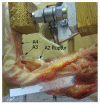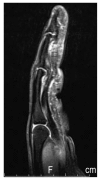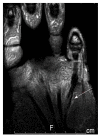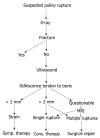Tendon injuries of the hand
- PMID: 22720265
- PMCID: PMC3377907
- DOI: 10.5312/wjo.v3.i6.62
Tendon injuries of the hand
Abstract
Tendon injuries are the second most common injuries of the hand and therefore an important topic in trauma and orthopedic patients. Most injuries are open injuries to the flexor or extensor tendons, but less frequent injuries, e.g., damage to the functional system tendon sheath and pulley or dull avulsions, also need to be considered. After clinical examination, ultrasound and magnetic resonance imaging have proved to be important diagnostic tools. Tendon injuries mostly require surgical repair, dull avulsions of the distal phalanges extensor tendon can receive conservative therapy. Injuries of the flexor tendon sheath or single pulley injuries are treated conservatively and multiple pulley injuries receive surgical repair. In the postoperative course of flexor tendon injuries, the principle of early passive movement is important to trigger an "intrinsic" tendon healing to guarantee a good outcome. Many substances were evaluated to see if they improved tendon healing; however, little evidence was found. Nevertheless, hyaluronic acid may improve intrinsic tendon healing.
Keywords: Extensor tendon; Flexor tendon; Pulley injury; Tendon lesion; Tendon sheath.
Figures









References
-
- Voigt C. [Tendon injuries of the hand] Chirurg. 2002;73:744–64; quiz 765-7. - PubMed
-
- Angermann P, Lohmann M. Injuries to the hand and wrist. A study of 50,272 injuries. J Hand Surg Br. 1993;18:642–644. - PubMed
-
- Schöffl VR, Schöffl I. Injuries to the finger flexor pulley system in rock climbers: current concepts. J Hand Surg Am. 2006;31:647–654. - PubMed
-
- Schöffl I, Oppelt K, Jüngert J, Schweizer A, Bayer T, Neuhuber W, Schöffl V. The influence of concentric and eccentric loading on the finger pulley system. J Biomech. 2009;42:2124–2128. - PubMed
-
- Schöffl I, Oppelt K, Jüngert J, Schweizer A, Neuhuber W, Schöffl V. The influence of the crimp and slope grip position on the finger pulley system. J Biomech. 2009;42:2183–2187. - PubMed
LinkOut - more resources
Full Text Sources
Other Literature Sources
Medical

